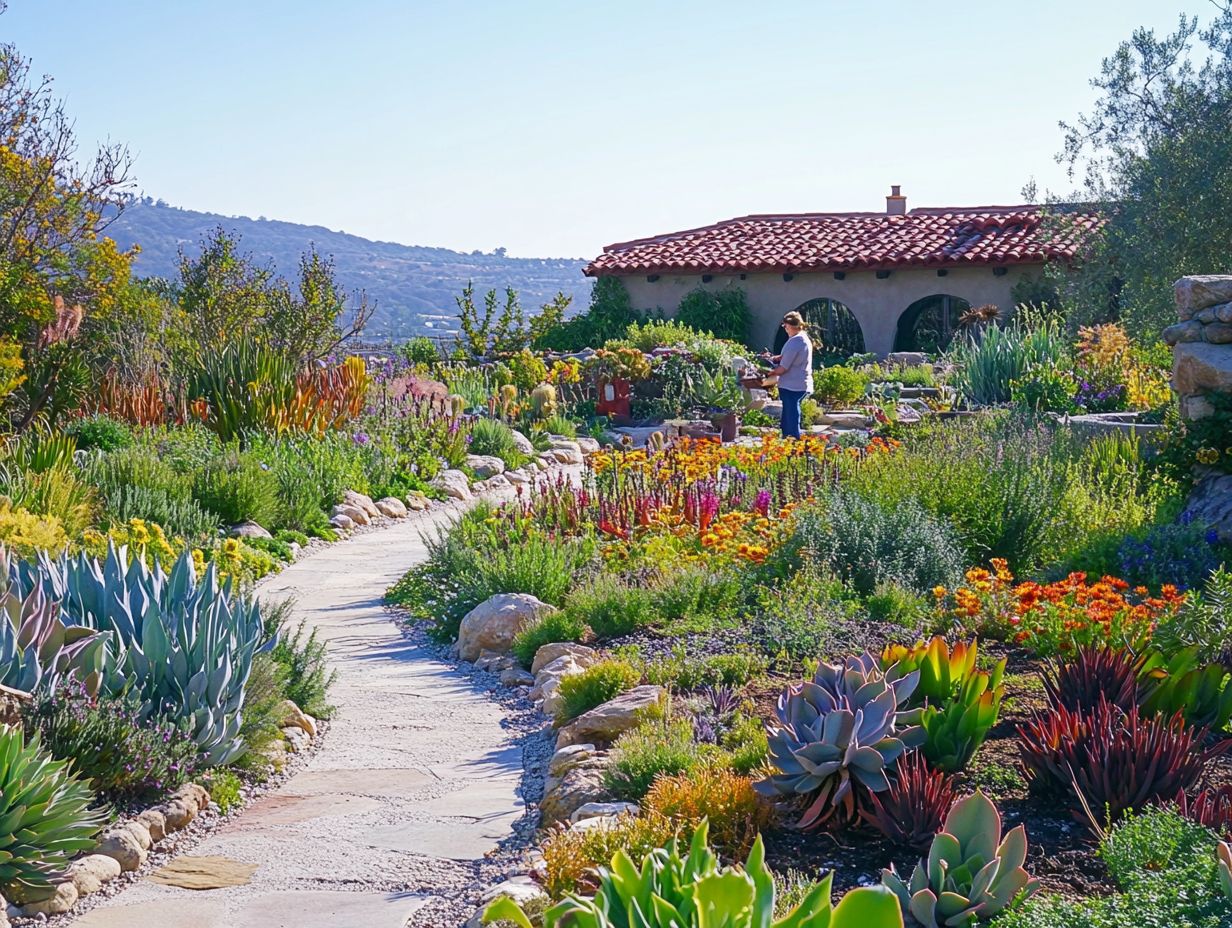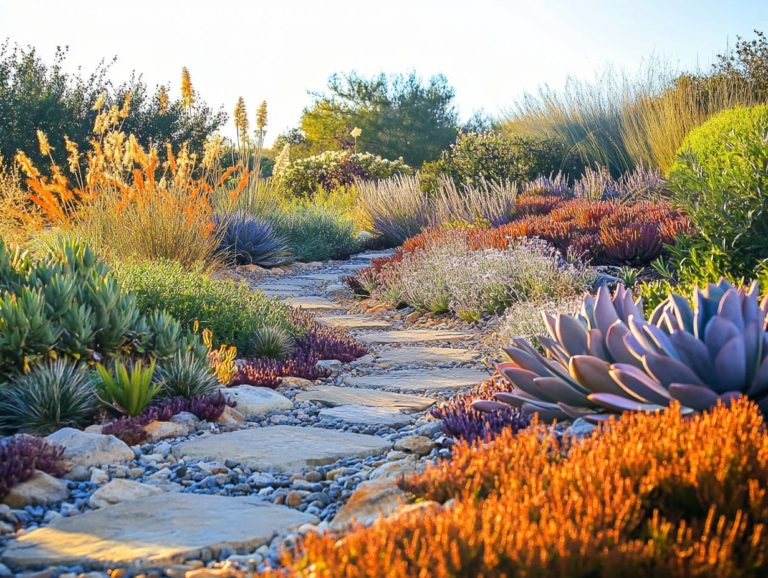The Health Benefits of Gardening with Drought Plants
In a world where water conservation is becoming essential, gardening with drought-resistant plants presents a practical and fulfilling solution.
These resilient species not only thrive in arid conditions but also offer a multitude of environmental and health benefits.
This exploration delves into the essentials of drought gardening, guiding you through the process of selecting the right plants and caring for them effectively.
You ll also uncover garden design techniques and alternative gardening methods, such as xeriscaping.
Embrace the opportunity to create a sustainable oasis that flourishes even in dry conditions.
Contents
- Key Takeaways:
- Benefits of Gardening with Drought Plants
- How to Choose and Care for Drought Plants
- Designing a Drought-Resistant Garden
- Alternative Gardening Methods for Drought Conditions
- Frequently Asked Questions
- What are drought plants and how can they benefit my health and improved nutrition?
- What are the air quality benefits of gardening with drought plants?
- How does gardening with drought plants reduce stress levels?
- What physical health benefits can be gained from gardening with drought plants?
- Are there any mental health benefits associated with gardening with drought plants?
- Can gardening with drought plants be beneficial for the environment?
Key Takeaways:

What are Drought Plants?
Drought plants are specially adapted species that thrive in environments with limited water availability, making them essential for sustainable gardening practices, particularly in regions prone to drought, such as California and Australia. By incorporating these native plants into your garden, you not only reduce the need for irrigation but also contribute to soil health, fostering biodiversity and enhancing local ecosystems. Understanding the importance of drought-resistant plants in landscaping can further support these efforts.
Their remarkable resilience allows them to store moisture efficiently and withstand periods of extreme heat. This adaptability makes them invaluable allies in community gardens where water conservation is a priority. You can cultivate a vibrant array of flora while minimizing resource consumption, all thanks to these hardy companions.
As these plants thrive, they create habitats that attract a diverse range of pollinators and beneficial insects, promoting a healthier balance within your garden’s ecosystem. Additionally, their extensive root systems enrich the soil, enhancing nutrient availability and boosting microbial activity. This ultimately leads to improved soil health and a more sustainable approach to gardening that you can feel good about.
Benefits of Gardening with Drought Plants
Gardening with drought-resistant plants presents a wealth of advantages, not just for the environment but also for your personal well-being. Research indicates that engaging in physical activity through gardening can significantly boost your emotional health, enhance your nutrition, and foster mindfulness, highlighting the psychological benefits of drought gardening.
Embracing this practice allows you to cultivate a vibrant garden while nurturing your body and mind.
Environmental Benefits
The environmental benefits of using drought-resistant plants in your gardening endeavors are truly remarkable. By selecting these resilient species, you not only minimize water consumption but also enhance soil health and provide vital habitats that support local wildlife. To learn more about these advantages, explore the environmental benefits of drought gardening.
When you choose native drought-tolerant plants, you have the opportunity to create stunning landscapes that flourish even in arid conditions, contributing positively to the ecosystem. Take plants like sagebrush and lavender, for example; they require minimal water while their deep root systems improve soil structure, reducing erosion and promoting nutrient cycling.
Moreover, these plants are magnets for pollinators such as bees and butterflies, enriching local biodiversity. By incorporating these species into your sustainable gardening practices, you actively conserve precious irrigation resources during dry spells, making your community gardens more resilient.
This collaborative approach to gardening not only nurtures a healthy environment but also fosters a harmonious balance between human needs and nature s intrinsic rhythms.
Health Benefits

Gardening with drought-resistant plants not only supports environmental conservation but also brings a host of health benefits your way. You’ll find yourself engaging in more physical activity and basking in the sun for essential vitamin D. Plus, exploring the long-term benefits of drought gardening enhances your emotional well-being, particularly during stressful times like the COVID-19 pandemic.
When you dive into this gardening journey, you ll be actively digging, planting, and tending to your garden. This naturally boosts your physical activity levels and contributes positively to your cardiovascular health. As you reap the rewards of your labor by harvesting fresh fruits and vegetables, you’ll enrich your diet with nutritious produce, significantly enhancing your overall wellness.
Gardening is a holistic approach to nurturing both body and mind. It allows you to immerse yourself in your surroundings, cultivate gratitude, and take a breather from the chaos of daily life, easing symptoms of anxiety and depression in the process.
In essence, gardening offers a therapeutic outlet alongside substantial rewards in nutrition and well-being.
How to Choose and Care for Drought Plants
Choosing and nurturing drought-resistant plants requires a keen understanding of several critical factors, including climate, soil type, and the unique characteristics of each plant. Understanding these factors is essential for achieving successful gardening and promoting sustainable practices.
Factors to Consider
When selecting drought-resistant plants for your garden, take a moment to consider factors like the local climate and soil type. How well do native plants mesh with your existing gardening setup? This thoughtful approach will lead to optimal growth and sustainability.
The local climate is pivotal; varying temperatures, rainfall patterns, and seasonal shifts can significantly impact plant survival. For example, if you live in an area with long, scorching summers, you ll need to choose different species than someone in a region with mild, wet winters.
Understanding your soil type whether it’s sandy, clayey, or loamy is essential as it affects water drainage and nutrient absorption. Opting for plants native to your area not only enhances the ecosystem but ensures these plants are well-suited to local conditions. This means they ll need less maintenance and resources.
Incorporating native species boosts biodiversity and creates a vibrant ecosystem in your garden!
Tips for Proper Care
Caring for drought-resistant plants is essential for a flourishing garden! Start by keeping an eye on how wet or dry your soil is. This simple habit helps your plants thrive.
Embrace organic gardening practices and encourage friendly tiny organisms in the soil that help your plants grow stronger. This thoughtful approach ensures your plants receive just the right amount of hydration, promoting deeper root systems that can tap into moisture reserves.
Consider integrating mulch to help retain that precious soil moisture. Choosing the right soil amendments, or additions to improve soil quality, like compost, can significantly improve both the structure and nutrient content of your soil.
For pest control, opt for natural remedies like neem oil or insecticidal soap. These methods effectively manage unwanted pests while preserving beneficial organisms.
By emphasizing these organic techniques, you not only cultivate a thriving garden environment but also contribute to the overall vitality of the ecosystem, enhancing the resilience of your drought plants.
Designing a Drought-Resistant Garden

Designing a drought-resistant garden demands careful planning on your part. You’ll want to thoughtfully select native plants, create strategic layouts, and incorporate essential elements that enhance water conservation and sustainability.
Each decision contributes to a thriving, eco-friendly space that stands resilient in the face of dry conditions.
Key Elements and Techniques
Creating a drought-resistant garden involves enhancing your soil, utilizing mulch, and selecting drought-tolerant native plants that thrive in arid conditions.
Prioritizing organic matter and improving soil structure significantly boosts the soil’s ability to retain moisture essential in drought-prone areas. Implementing water-efficient landscaping practices, like grouping plants with similar water needs, helps reduce overall irrigation requirements.
Strategic planting techniques, such as swales and rain gardens, effectively channel water to where it’s needed most while minimizing runoff. Integrating drip irrigation optimizes water usage, ensuring each plant receives the necessary moisture without waste.
These thoughtful strategies not only create a sustainable garden but also foster a thriving ecosystem, even in challenging climates.
Alternative Gardening Methods for Drought Conditions
Alternative gardening methods like xeriscaping offer innovative solutions to maintain stunning landscapes in drought conditions while dramatically cutting down on water usage.
Xeriscaping and Other Options
Xeriscaping is a gardening method designed to minimize or eliminate the need for irrigation in arid environments. It emphasizes drought-resistant plants and efficient water utilization.
This approach conserves precious water resources and champions sustainable gardening practices essential in a world facing climate challenges. By choosing native plants adapted to local conditions, you can cultivate vibrant, low-maintenance landscapes that flourish with minimal resources.
Beyond its water-saving advantages, xeriscaping reduces reliance on chemical fertilizers and pesticides, fostering healthier soil and thriving habitats for local wildlife. This practice supports soil health and encourages the activity of beneficial soil microbes.
You ll enjoy a beautiful garden that nurtures both the environment and your personal well-being, enhancing your emotional wellness through the joy of working with nature.
Frequently Asked Questions

What are drought plants and how can they benefit my health and improved nutrition?
Drought plants are resilient and able to survive in low-water conditions. Gardening with these plants can improve your health by enhancing air quality, reducing stress levels, and promoting physical activity, while also providing access to organic produce. Additionally, exploring the benefits of drought-resistant gardening can further highlight the advantages of this sustainable practice.
What are the air quality benefits of gardening with drought plants?
Drought plants, such as succulents and cacti, absorb pollutants and produce oxygen, improving air quality in your home and outdoor space. They also help filter out harmful toxins, keeping the air clean and healthy.
How does gardening with drought plants reduce stress levels?
Gardening calms the mind, and the low-maintenance nature of drought plants makes it a relaxing activity. By using native plants in drought gardening, you can enjoy this outdoor activity while soaking up vitamin D and boosting your mood, providing significant stress relief.
What physical health benefits can be gained from gardening with drought plants?
Gardening with drought plants involves physical activity that can improve muscle strength and flexibility. Additionally, it burns calories and contributes to a healthy lifestyle, especially when you transform your garden with drought benefits.
Are there any mental health benefits associated with gardening with drought plants?
Studies show that gardening can enhance overall mental well-being by reducing symptoms of depression, boosting self-esteem, and promoting relaxation and mindfulness in gardening. Additionally, gardening with drought plants offers these benefits while being a low-maintenance and budget-friendly hobby.
Can gardening with drought plants be beneficial for the environment?
Absolutely! Drought plants need less water and can thrive even in dry conditions.
By adding these plants to your garden, you help save water. You also contribute to a healthier planet and can engage more with your local gardening community!






